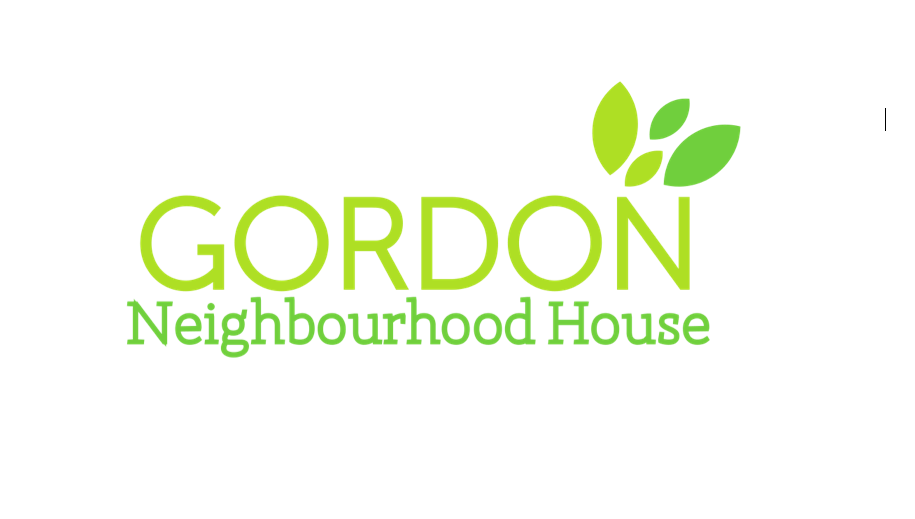Hello and welcome to our blog post #3, the second last blog post following our adventures working with Gordon Neighbourhood House!
Weekly Objectives and Achievements
What? This week we intended to finalize and execute our Day 1 of the program. We had unanimously decided that for the first day, our main activity was going to be baking bread, to increase food literacy through introducing basic cooking skills. In addition to baking, we planned to assess other aspects of food literacy through personal interviews with the kids.
As we mentioned in our last blog posting, this week we intended to finalize and execute our Day 1 of the program. We had unanimously decided that for the first day we were going to bake bread with the kids. This activity along with verbal questioning would allow us to assess their level of competency in the kitchen.
As a group we met the day prior to our program to test out the recipe and ensure everything would run smoothly on the day. This meeting also allowed us to better explain to the kids what would, and had occurred during the baking process. Additionally, it allowed us to bring a healthy snack to Gordon Neighbourhood House for the kids to try as they waited for their own bread to rise. We also researched and chose additional food science activities to do while waiting for the bread to rise; such as the polyphenol oxidation reaction of banana peels, and surface tension repulsion between milk and detergent. All objectives previously planned for this week were executed successfully.
Workshop Day one…
Overall we agreed that the execution of our lesson plan went as smooth as possible. We arrived as a group with plenty of time to spare before the 3:30 pm arrival of our 16 participants, we set the room up into four stations; 1. Bread making, 2. Polyphenol oxidation of banana peels, 3. Surface tension using milk and dish detergent, 4. Vegetable colouring sheets.
It was a bit of a struggle to gain control of the room, but once all children were seated we were able to ask names and a favourite food; nearly ¾ of the children stated pizza as their favourite food. After getting to know a bit about the kids we brought them over to our first station to start making the bread. Here we asked the groups if they had baked before to assess basic kitchen skills (the majority stated they had), if they had ever specifically baked bread (only a couple had), and if they knew the ingredient that would make the bread rise (answers given included flour, and the correct answer yeast). At this station we further broke into groups of three so that each group had 1-2 of us assisting them and coordinating the sharing of roles amongst the kids. As the first stages of bread-making were complete and bread needed to rise, children were able to choose which station they would like to go to next. After the bread completed its first rise, those who wanted to came back to complete the next steps. While the bread was rising a second time we prepared the bread we had made the day prior to give as a sample of what their bread would be like. Many children requested excessive use of butter on their bread, one child even asked for salt to be put on top of the butter.
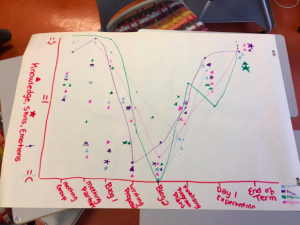
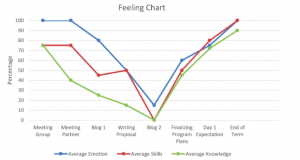
So what? After completing the graph in the “Moments of Significant Change” workshop, we noticed that we all had very similar feelings throughout our experience thus far. We all felt very excited when we met our group; We realized that we all had a lot in common. We all possessed the skills needed to accomplish our tasks because of our individual experiences working with children, and our knowledge in the health field. We are all a couple years older than the average third year student, which made us have a certain level of respect for one another, and because of this we were able to relate better to each other. This instant camaraderie amongst the group made us feel as though communication between the six of us was going to be easy, and would hopefully make this project flow smoothly.
Upon meeting our community coordinator, Isabel, we all felt very confident about our project. What we had been told when choosing the project in lecture when choosing the project aligned with what we were told by Isabel. This gave us confidence in our project in terms of what we were going to do with the kids and as a team we felt that we were prepared to tackle the project especially because we were expecting the challenges as outlined when we choose the project. Isabel was also very friendly and made us feel comfortable working with her especially with our communicators that need to be in touch with her. She felt like a resource instead of a boss and we were excited to start brainstorming food science activities and meet the kids. This was especially important for our group communicator, Megan, who will be in contact with Isabel throughout the length of the project. We saw Isabel as a valuable resource, and we were excited to start brainstorming food science activities and to meet the kids. Our knowledge on the low end because we were trying something new, but our skills were high because we believed that we still possessed the important skills needed for our project.
Writing and submitting blog post number one was more of a mixed experience. Overall, we were all looking forward to the idea of creating our own blog. We were excited to introduce ourselves, take a fun photo, and to write and share about our experiences in a personable and interactive way. Unfortunately, when it came down to creating the blog, none of us had any experience. As you can see on the graph, our skills and knowledge dropped drastically at this point. Not only did we lack experience, but it was very daunting looking at last year’s group’s blog posts. The instructions we were given regarding the blog were hard to follow, and initially we made a mistake when submitting the blog to our instructor. This had an effect on where we plotted our knowledge and skills at this point on the graph.
Preparing our proposal was difficult and our emotions, skills and knowledge dropped here. The hardest part about this assignment for us was figuring out where to start. With minimal resources and a vague idea of what was being asked of us, we hard a hard time getting the first words onto the page. Although we briefly went over the basics of a proposal in class, we felt that we lacked the skills and knowledge to actually write our own proposal. The lack of skills and the lack of knowledge on where to start and what was being asked of us was where we lost a lot of our excitement for this project; This is apparent on the graph, showing a steep drop in emotion.
We really struggled with blog post number two three as well, as seen in the graph. We had trouble getting started and our knowledge about the project felt low. We did little to progress our project in the weeks leading up to blog post 2; Because of this, we felt that we had little to write on. A lot of our time was spent working on the proposal and focusing on class readings; And when it came down to what were were going to be doing at the community house, we had yet to really sit down and discuss it with all the team members. It was also over reading week (aka university spring break) when we had to collaborate to get this blog post submitted, and this added stress to the assignment. For all of these reasons, our emotions were at their lowest.
We started to regain our excitement and momentum when we finalized our lesson plan for our first trip to GNH. This was an activity we all felt confident in, we had lots of ideas to contribute, and we were having fun putting everything together.We all felt confident in our lesson plan, and we had lots of ideas to contribute. We were even having fun putting everything together! Our skills went up on the graph, as we were excited to have the opportunity to use the skills we possessed in working with children in Day 1 of our program. We felt knowledgeable in this task, and we had clear directions going forward from our instructors and from Isabel. Our emotions went up as well, as we were able to communicate and collaborate with each other in a productive manner; Overall, we felt confident in how our assignment was proceeding.
Prior to our first workshop with the kids at GNH, we all felt excited but nervous meeting the kids for the first time. As presenting anything for the first, we were anxious at how we would perform and if we were going to be able to accomplish our goal of creating a fun learning environment We were very pleasantly surprised at how well our group was able to work together efficiently to create a positive experience for the kids and ourselves. We collectively decided that 4 activities we chose were appropriate for the kids age and involved technical food science terms that we could teach them.
We decided that the banana peel activity was a fun activity where the kids could learn about the science behind bananas turning brown. We felt that using fruit that the kids were all familiar with was a good way to engage their learning and interest in food science. We were unsure of a few things going in, such as supplies, logistics of our experiment, transportation and transitions from one experience to the next. We felt that using simple ingredients such as banana, milk, flour among others that the kids normally would have access to was the best approach into opening up their mind about food science. After our experience, we felt knowledgeable about what were were doing as a team and felt reassured with the support of our teachers and Isabel behind us.
To execute a smoother workshop in the future, we will take things we learned from this first session (such as to take the kids to the park first so they can get rid of all their energy and thus listen a bit better), and transfer it over to the second workshop in order to ensure that the kids are able to have fun and retain the most information. We hope to have every kid participate in our next workshop and feel comfortable to communicate with us about how they feel regarding our workshops or what they learn. Our ultimate goal is to have the kids apply their learning at home with their friends and family. Integrating the practical skills we teach them at an early age is important to help them understand that nutrition can be fun and that eating healthy food should be a lifestyle.
We didn’t really have much time to get into a discussion about the end of the term but we all knew that we would feel more skilled and knowledgeable by the time the term concluded. It would be different than when we first started due to the experience and exposure we will have had throughout the term. We outlined some strategies we hope to implement at the end of this blog to successfully complete the term and hopefully keep our emotions up through this stressful time.
We came to the overall conclusion while during our discussion about the significant change we all agreed that we were all feeling overwhelmed with both workload and lack of clarity with all the assignment around the time blog 2 was submitted. The was feeling was realized and affected us around the time blog 2 was submitted. Since then we have managed to increase clarity within the group and learned to ask for help from our TA when confused. , and After executing day one of the program we have increased or skills, knowledge, and confidence, as it relates to working with this particular group of children, and increasing food literacy. Moving forward towards the end of the term, as a group we foresee confidence, skills, and knowledge, continuing on an upward trend, reflecting that which we thought we had earlier on.

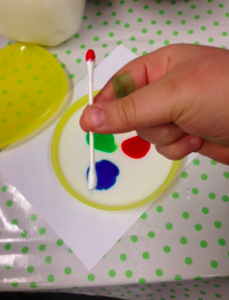

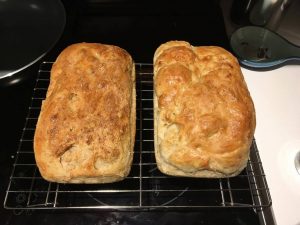
Successful Project Completion the Graceful Dismount
Prior to our first workshop with the kids at GNH, we all felt excited but nervous meeting the kids for the first time. We were very pleasantly surprised at how well our group was able to work together efficiently to create a positive experience for the kids and ourselves. Going into the first workshop, we all felt a bit anxious about how things would turn out, as presenting anything for the first time feels like. Nonetheless we all felt proud and happy by the end of it! To help us have a “graceful dismount” from our project, we will take things we learned from this first session (such as to take the kids to the park first so they can get rid of all their energy and thus listen a bit better), and transfer it over to the second workshop in order to ensure that the kids are able to have fun and retain the most information. We hope to have every kid participate in our next workshop and feel comfortable to communicate with us about how they feel regarding our workshops or what they learn. We also want to leave a positive impression of UBC on the Gordon Neighbourhood House, so it is essential for us to try our best to make the second session as positive of an experience as possible. In order to achieve a successful project completion, we will utilize our teamwork and communication skills to understand everyone’s role and make the next couple of weeks run efficiently. We feel that meeting with the group prior to the visits have been very helpful and beneficial so we all have a clear understanding of what is to be expected. Based on the first workshop, we now have a better understanding of what kind of activities to do and how to manage time more efficiently. We feel that it is important for all the kids to participate actively so they can share their feelings with each other and be able to pass on their learning to their friends and family at home. We want to explore more challenging but fun activities for the kids to enlighten their learning and we feel that the first workshop has really helped us understand their level of knowledge regarding nutrition and food science. We were very pleased to have every member of the group present at the workshop and engage with the kids so we can see as a team how to improve ourselves for the next workshop and achieve the “graceful dismount.”
Now what? As we wrap up the semester and our community project there are a few goals we would like to accomplish and finish to have, what we feel to be, a successful completion and a graceful dismount.
We would like to leave on a positive note with our community partner, the GNH, by providing impactful workshops. To accomplish this, we have tried our best to make each session a positive learning environment. After the first session, we have more insights on what to do to make the second session more engaging. Using insights like keeping this simple, using better time management strategies to make things more efficient and getting more feedback from the children will be our strategy to create a more successful session. We feel that it is important for all the kids to participate actively so we are going to make more of an effort to engage each child. We want to start more conversations with the children about food literacy and food science learn enough to be able to pass on their new insights to their friends and family at home. We want to
explore more challenging but fun activities for the kids to enlighten their
learning and we feel that the first workshop has really helped us understand
their level of knowledge regarding nutrition and food science so we are able to
build off that. By ending on our last and most refined session, we hope to
leave a good impression of the children as well as the community partner coordinators. We plan to be thankful and appreciative to our coordinators who have given us the opportunity and welcomed us into the GNH.
We would like to use the skills we have learned to work as a team to finish with a strong final assignment and presentation. We have learned many valuable lessons regarding working as a team with our unique group. Understanding what works for us in terms of dividing work and getting projects in on time (finally figured that out!) was curtail to our success as a team and we will use this knowledge as we go forward. Practicing communication throughout the term we have developed a strategy that works to keep us all in the loop. We felt that meeting before we presented at the GNH helped us feel more prepared and confident so we will continue to do that. We feel confident that we can successful complete the last few projects of the term by utilizing the strategies we have learned.
Using the strategies mentioned above we feel confident that we can execute a graceful dismount and end the term on a great note!
Tune in next time for our very last blog post!! We are very excited for the next workshop and to WOW the kids with even more Food Science fun!!
